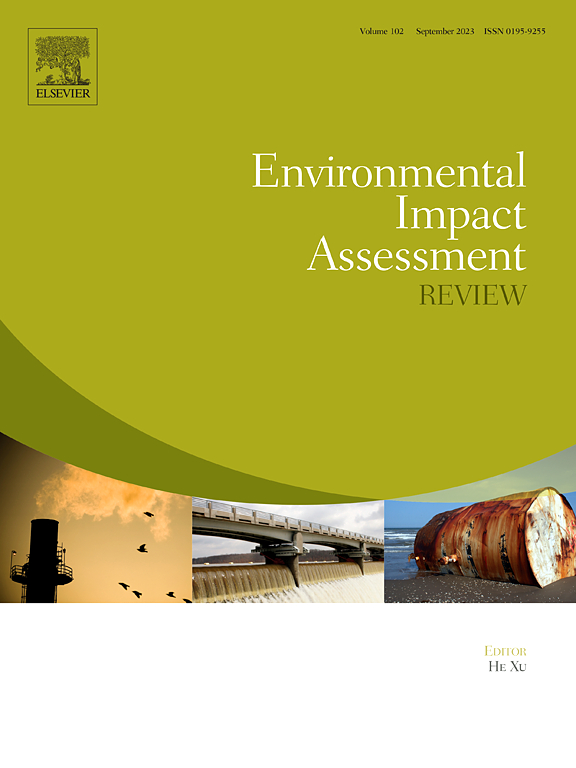Impact of cropland use transformation on ecosystem carbon sinks in a typical agroforestry mixed region: An analysis from explicit and implicit perspectives
IF 9.8
1区 社会学
Q1 ENVIRONMENTAL STUDIES
引用次数: 0
Abstract
Cropland use transformation (CUT) not only increases grain production but also considerably impacts regional ecosystem carbon sinks. However, comprehensive studies exploring connections between CUT and ecosystem carbon sinks are limited. We constructed an indicator system and transformation framework for CUT by considering explicit and implicit dimensions. Moreover, we analyzed changes in the CUT in the middle and lower reaches of the Yangtze River Basin (MLYB), as well as the trends in net ecosystem productivity (NEP). Structural equation modeling was used to explore the direct and indirect impacts of CUT on NEP. The MLYB lost approximately 0.82–0.86 × 103 km2 of cropland annually, with the cropland being primarily transformed into construction and forest land. The proportion of the three major grain crops showed fluctuating increases. The average NEP in the MLYB from 1999 to 2019 was 549.36 gC/m2/yr, while the capacity of ecosystem carbon sinks gradually weakened, with approximately 29.96 % of the area showing a highly significant degradation trend, and 19.42 % showing a significant degradation trend. In terms of explicit CUT indicators, the total effect of the cropland area on NEP was negative, with a direct effect of −0.21, an indirect effect of 0.10, and a total effect of −0.11. The overall effect of the cropping structure on NEP was positive, with a direct effect of 0.21, an indirect effect of 0.02, and a total effect of 0.23. Regarding implicit CUT indicators, the input of agricultural production factors directly inhibited ecosystem carbon sinks, with an effect value of −0.62. Cropland output directly promoted NEP, with an effect value of 0.65. This study explains the relationship between CUT and ecosystem carbon sinks, providing a scientific basis for advancing green agriculture in China.
典型农林混交区耕地利用转型对生态系统碳汇的影响——显性与隐性视角分析
耕地利用转化不仅增加了粮食产量,而且对区域生态系统碳汇产生了重大影响。然而,全面探讨CUT与生态系统碳汇之间关系的研究有限。从显性和隐性两个维度出发,构建了CUT的指标体系和转换框架。此外,本文还分析了长江中下游生态系统净生产力(NEP)的变化趋势。采用结构方程模型探讨了CUT对NEP的直接和间接影响。年均耕地损失约0.82 ~ 0.86 × 103 km2,耕地以建设用地和林地为主。三种主要粮食作物所占比重呈波动上升趋势。1999 - 2019年MLYB平均NEP为549.36 gC/m2/yr,生态系统碳汇容量逐渐减弱,约29.96%的区域呈现高度显著退化趋势,19.42%的区域呈现显著退化趋势。在显性CUT指标上,耕地面积对NEP的总效应为负,直接效应为- 0.21,间接效应为0.10,总效应为- 0.11。种植结构对NEP的总体影响为正,直接效应为0.21,间接效应为0.02,总效应为0.23。在隐性CUT指标上,农业生产要素投入直接抑制生态系统碳汇,影响值为−0.62。耕地产量直接促进新经济政策,效应值为0.65。本研究解释了CUT与生态系统碳汇的关系,为中国推进绿色农业提供了科学依据。
本文章由计算机程序翻译,如有差异,请以英文原文为准。
求助全文
约1分钟内获得全文
求助全文
来源期刊

Environmental Impact Assessment Review
ENVIRONMENTAL STUDIES-
CiteScore
12.60
自引率
10.10%
发文量
200
审稿时长
33 days
期刊介绍:
Environmental Impact Assessment Review is an interdisciplinary journal that serves a global audience of practitioners, policymakers, and academics involved in assessing the environmental impact of policies, projects, processes, and products. The journal focuses on innovative theory and practice in environmental impact assessment (EIA). Papers are expected to present innovative ideas, be topical, and coherent. The journal emphasizes concepts, methods, techniques, approaches, and systems related to EIA theory and practice.
 求助内容:
求助内容: 应助结果提醒方式:
应助结果提醒方式:


